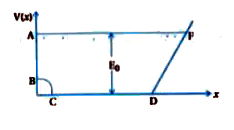Two blocks M1andM2 having equal mass are free to move on a horizontal frictionless surface . M2 is attached to a massless spring as shown in figure .Intially M2 is at rest and M1 is moving toward M2 with speed v and collides head - on with M2 .
 Solution in Gujrati
Solution in Gujrati
While spring is fully compressed all the KE of M1 is stored as PE of spring .
While spring fully compressed the system momentum is not conserved ,through final momentum is equal to intial momentum .
If spring surface on which blocksare moving has friction , then collision cannot be elastic
If the surface o which blocks are moving has friction ,then collision cannot be elastic
The correct Answer is:C
When m1 comes in contact with M2,M1 is retarded and M2 is accelerated .
(A) The spring will continue to compress until the two blocks acquire will be conserved .
(C ) Is spring is massless whole energy of M1 will be impared to M2andM1 will be at rest , then
(D) Collision is inelastic ,even if friction is not involved .
Topper's Solved these Questions
- WORK, ENERGY AND POWER BOOK - KUMAR PRAKASHANCHAPTER - WORK, ENERGY AND POWER EXERCISE - SECTION - D NCERT Exemplar Solutions (Very Short Answer Type Questions)
12 Videos
- WORK, ENERGY AND POWER BOOK - KUMAR PRAKASHANCHAPTER - WORK, ENERGY AND POWER EXERCISE - SECTION - D NCERT Exemplar Solutions (Short Answer Type Questions)
10 Videos
- WORK, ENERGY AND POWER BOOK - KUMAR PRAKASHANCHAPTER - WORK, ENERGY AND POWER EXERCISE - SECTION - C Objective Questions (VSQs)
52 Videos
- WAVESBOOK - KUMAR PRAKASHANCHAPTER - WAVESEXERCISE - SECTION-F (Questions From Module) (Sample questions for preparation of competitive exams)
23 Videos
Similar Questions
A through inclined is placed on car moving with a constant velocity u on horizontal ground . A block of mass M rests on the inclined plane . Is any work done by force of friction then a dissipation of energy ?
View SolutionA graph of potential energy V(x) verses x is shown in figure .A particle of energy E0 is executing motion in it . Draw graph of velocity and kinetic energy verses x for one complete cycle AFA.

View SolutionIf →A=2ˆi−2ˆjand→B=2ˆk then →A.→B……
View SolutionIn a standing wave formed by two atoms separated by 1.21Å, there are 3 nodes and 2 antinodes. Find its wavelength.
View SolutionTwo block of masses m_(1) and m_(2) are connected as shown in the figure. The acceleration of the block m_(2) is:
View SolutionTwo blocks M_(1) and M_(2) having equal mass are free to move on a horizontal frictionless surface. M_(2) is attached to a massless spring as shown in figure. Initially M_(2) is at rest and M_(1) is moving toward M_(2) with speed upsilon and collides head-on with M_(2) .
View SolutionTwo blocks of mass m1 and m2 (m1<m2) are connected with an ideal spring on a smooth horizontal surface as shown in figure. At t = 0 m1 is at rest and m2 is given a velocity v towards right. At this moment, spring is in its natural length. Then choose the correct alternative :

View SolutionTwo masses m1 and m2 are attached to a spring balance S as shown in figure. m1>m2 then the reading of spring balance will be .
 .
.
View SolutionA particle of mass m_(1) collides head on with a stationary particles of mass m_(2) . If (m_(1))/(m_(2)) gte, where e is the coefficient of restitution, then :
View SolutionTwo blocks of masses m_(1) and m_(2) are kept on a smooth horizontal table as shown in figure. Block of mass m_(1) (but not m_(2) is fastened to the spring. If now both the blocks are pushed to the left so that the spring is compressed a distance d. The amplitude of oscillatin of block of mass m_(1) after the system is released is
View SolutionTwo masses m1 and m2(m2>m1) are hanging vertically over frictionless pulley. The acceleration of the two masses is :

View SolutionA ball of mass m_(1) is moving with velocity 3v. It collides head on elastically with a stationary ball of mass m_(2) . The velocity of both the balls become v after collision. Then the value of the ratio (m_(2))/( m_(1)) is
View SolutionTwo masses m_(1) and m_(2) are attached to a spring balance S as shown in Figure. If m_(1)gt m_(2) then the reading of spring balance will be
View SolutionA spring is loaded with two blocks m1andm2 where m1 is rigidly fixed with the spring and m2 is just kept on the block m1 as shown in the figure. The maximum energy of oscillation that is possible for the system having the block m2 in constact with m1 is

View SolutionTwo blocks M1 and M2 having equal mass are free to move on a horizontal frictionless surface. M2 is attached to a massless spring as shown in figure. Initially M2 is at rest and M1 is moving toward M2 with speed υ and collides head-on with M2.

View Solution
